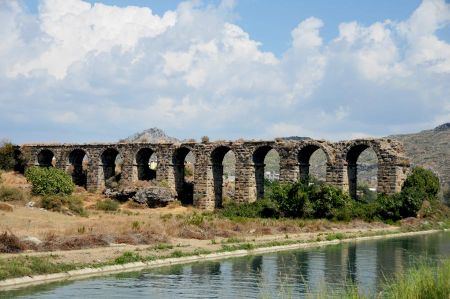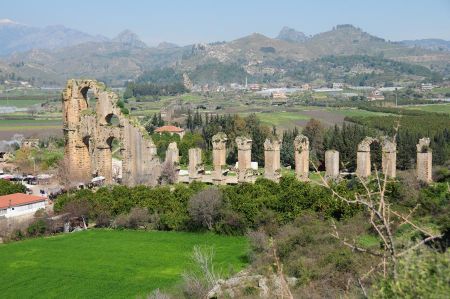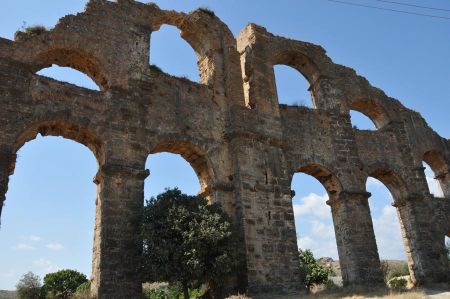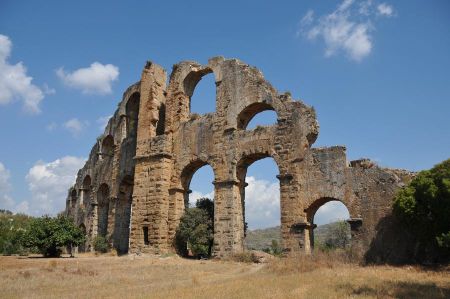The Viaduct of Aspendos next to Side
- Written by Portal Editor
Shortly after our return to Turkey for going to Aspendos, after an extensive round trip through Germany, our friend Detlef from Halle announced that he would be visiting us for the coming weekend.
Detlef spends his holidays in Gazipasa and as so often we wanted to think about a short trip for the following day in the evening, which is usually not a big problem given the multitude of possibilities on the Turkish Riviera. So on Friday afternoon we were already sitting bent over the map and discussing a destination for the coming day. Since Detlef is not a newcomer to the Riviera either and we had already done a number of tours together, I was surprised that Detlef did not yet know the Aspendos viaduct. A picture in Allan Huglstadt's travel guide, which we were also able to show him on the occasion, gave us the idea.
Aspendos Theater and Aspendos Viaduct
So on the following Saturday morning we set off in the direction of Antalya, where we followed the signs to Aspendos, turning right just before Serik. We had already visited the theater of Aspendos and the viaduct of Aspendos several times, but it is always fascinating to see these mighty and very well-preserved Roman buildings up close.
Many visitors to Turkey will certainly be familiar with the Aspendos theater at least since the show with Thomas Gottschalk “Wetten das” a few years ago. We were lucky enough to see the dance show "Fire of Anatolya" there.
Despite the many visitors to the theater of Aspendos, the ancient city situated above on the same hill is little known and visitors are not often seen there. The travel guides bring the tourists more to Perge.
The Viaduct of Aspendos - mighty remains of the wall
Also little known is the viaduct of the Romans, which had to be built to supply the city lying on the hill with fresh water.
Actually hardly understandable, because it is considered an absolute "highlight" of Roman hydraulic engineering. In addition, large parts of the viaduct are in surprisingly good condition.
In Roman times there was sufficient fresh water from the spring opposite the city hill in the foothills of the Taurus about 17 kilometers away in Gökcepinar. The spring is still bubbling up today, but no longer enough to supply an entire city.
The high location of the city of Aspendos on the hill had the advantage of being about 60 meters above ground level, which made it easier to build the city defenses, but the supply of fresh water to the city was considerably problematic.
 Thanks to the architecture of the Romans, especially with regard to hydraulic structures, a solution was also possible.
Thanks to the architecture of the Romans, especially with regard to hydraulic structures, a solution was also possible.
Similar to other cities, to cross the valley, which is more than a kilometer wide here, a viaduct of about 30 meters high, bridging the entire valley to the Taurus, could have been built, but this would have been very expensive and static would have caused problems.
So why not use the naturally existing water pressure and the basic physical laws of the communicating water columns in parallel and build a pressure line that is based on the principle of pressure equalization in pipe systems.
Water tower as an inclined plane
 This knowledge was available to the Romans and was structurally implemented in Aspendos. The water was collected directly at the source and conducted through a system of pipes at a slightly falling level in the direction of the town of Aspendos up to a "water tower" at the edge of the valley. The water now flowed down into the valley over an inclined plane, which carried very massive pieces of pipe made of stone for the water supply. In order to be able to absorb the pressure of the water, the Romans made these pipes out of limestone in cubic meters, with the inner pipe diameter being 26 centimetres. Even today, individual raw pieces lie scattered on the ground along the viaduct.
This knowledge was available to the Romans and was structurally implemented in Aspendos. The water was collected directly at the source and conducted through a system of pipes at a slightly falling level in the direction of the town of Aspendos up to a "water tower" at the edge of the valley. The water now flowed down into the valley over an inclined plane, which carried very massive pieces of pipe made of stone for the water supply. In order to be able to absorb the pressure of the water, the Romans made these pipes out of limestone in cubic meters, with the inner pipe diameter being 26 centimetres. Even today, individual raw pieces lie scattered on the ground along the viaduct.
Every other piece of tubing has a hand hole in the side where a plug used to sit. These openings were used on the one hand for cleaning and on the other hand to reduce pressure surges that could otherwise have destroyed the limestone, the water pressure was so immense. Air always got into the pipe system with the water, so that sudden changes in the flow rate can occur, which usually means that the dreaded pressure surges migrate through the pipe system. In order to avoid destruction, as much air as possible had to be removed from the closed system. The Romans therefore built pressure equalization towers with open water tanks, to which the pressure line was then connected. The basic physical law of the communicating tubes then used the water to reach its original starting level again. That way the air could escape.
 The valley itself was bridged by around 100 column arches, which still clearly cross the entire valley in a straight line. Unfortunately, only about 40 sheets of it have survived. On the city side to Aspendos, the water now rose again in the pipe system, so that the level was at the same level as that necessary for the city's supply. Water continuously entered Aspendos via this pressure system, so that even a huge Nymphaion, a huge city fountain, could be built, from which the water was distributed in the city.
The valley itself was bridged by around 100 column arches, which still clearly cross the entire valley in a straight line. Unfortunately, only about 40 sheets of it have survived. On the city side to Aspendos, the water now rose again in the pipe system, so that the level was at the same level as that necessary for the city's supply. Water continuously entered Aspendos via this pressure system, so that even a huge Nymphaion, a huge city fountain, could be built, from which the water was distributed in the city.
The ruins of this fountain are also quite well preserved. Calculations of the flow rates have shown that about 65 liters of water per second were brought into the city through this aqueduct. This amount corresponds to about 5,600 cubic meters of water per day. With a population of around 15,000 in Aspendos, this suggests water consumption of around 370 liters per person per day, three times as much as is usual in Germany today. However, the Romans had no way of stopping the flow of water. However, the entire city was constantly flowed through by fresh water.
Ancient Aspendos on the hill
If you first drive towards the Aspendos Theater, you will get to the hill on which the ancient city is located. Please turn left here and drive around the city hill.
On the right side of the hill you can already see some ancient buildings, including a staircase. The ancient city itself has not been explored much, so far there have probably not been any excavations.
After almost circumnavigating the hill, you can already see the mighty construction of the viaduct, which is responsible for the rise of the water to the level of the city.
Between 25 and 30 meters, the segmental arches, mostly made of brick, still reach into the sky. The ramp of the pipeline is also still clearly visible.
 However, the “salespeople” waiting at the viaduct are a bit annoying. We are a bit annoyed because the bus driver parked his vehicle right next to the viaduct, which made it impossible to take photos. There is enough space everywhere.
However, the “salespeople” waiting at the viaduct are a bit annoying. We are a bit annoyed because the bus driver parked his vehicle right next to the viaduct, which made it impossible to take photos. There is enough space everywhere.
Without further ado, we continued on the path and reached the viaduct arches that cross the valley. Along a modern irrigation canal, we had reached a point where the size of the entire complex was clearly visible. What a masterful construction work for the water supply of a city. From here it was not far to the water tower on the Taurus side. We parked the vehicle on the outskirts of the village and first walked along the buildings to the valley. The view across to the ancient city was fascinating in itself, as the entire viaduct could only be overlooked. A boy of about 10 from the village joined us and had a lot to tell.
Staircase in the water tower of Aspendos
We then turned to the water tower, which is still mighty here, and thus also discovered the entrance to the stairwell in the tower, which leads to the point of collapse at a height of around 15 meters. Here, too, a mixed construction could be seen, consisting of partial brick masonry and natural stone, which was bonded by Roman "concrete".
Simply producing the quantities of bricks required to build the viaduct is hardly imaginable without mechanical production. The fuel required for burning alone must have swallowed up entire forests.
It is simply fascinating to see these feats of engineering that are almost 2,000 years old. The Roman Tiberius Claudius Italicus, who then gave the aqueduct to the city as a gift, is considered the master builder.
 Should you wish to hike along the aqueduct towards the ancient city, please do not stray off the beaten goat path as a multitude of underground cisterns are easily overlooked. The Nymphaion at the end had a diameter of almost 33 meters and a height of about 15 meters. Once completely clad in marble, there were niches where statues must have stood, reflecting the city's prosperity.
Should you wish to hike along the aqueduct towards the ancient city, please do not stray off the beaten goat path as a multitude of underground cisterns are easily overlooked. The Nymphaion at the end had a diameter of almost 33 meters and a height of about 15 meters. Once completely clad in marble, there were niches where statues must have stood, reflecting the city's prosperity.
We then left the aqueduct and found an idyllic spot on the Köprü river, where we settled down for a small picnic we had brought with us. The aqueduct was the focus of our conversations for a long time.
The Aspendos Viaduct – Experience Roman Engineering Up Close
Introduction to Aspendos
 If you've ever wondered how impressive Roman engineering was, a visit to Aspendos will provide the answer. This ancient city is located about 40 kilometres east of Antalya on the Turkish Riviera and boasts an impressive cultural heritage.
If you've ever wondered how impressive Roman engineering was, a visit to Aspendos will provide the answer. This ancient city is located about 40 kilometres east of Antalya on the Turkish Riviera and boasts an impressive cultural heritage.
Where is Aspendos?
Nestled in the picturesque landscape between the Taurus Mountains and the Mediterranean coast, Aspendos is ideal for a day trip.
Historical Significance of the Ancient City
Aspendos was an important trading centre in ancient times. However, it is best known for its remarkably well-preserved structures – including the world-famous theatre and the viaduct.
The Aspendos Viaduct – An Architectural Masterpiece
The Function of the Viaduct
The viaduct was part of an ingenious water supply system, transporting water from springs up to 17 km away directly to the city.
The Connection to the Ancient Water Supply
 Water was vital to survival in ancient cities. The Romans perfected the aqueduct system to utilize even more distant springs.
Water was vital to survival in ancient cities. The Romans perfected the aqueduct system to utilize even more distant springs.
Technical Details of the Structure
Length, Height, and Construction
The Aspendos Viaduct measures approximately 15 meters at its greatest height and impresses with its massive piers, precisely aligned arches, and robust stone joints.
Use of Natural Materials
It was built primarily with local limestone – sustainable, local, and extremely durable.
The Roman Aqueduct – Origin and Destination
Water Sources and Route
The aqueduct began in the hills, northeast of Aspendos, where several springs converged.
Endpoint: The city of Aspendos
The water reached the city centre – to public fountains, thermal baths, and residential buildings.
The Importance for the Roman City
Water Supply as the Basis of Urban Development
 Without the viaduct, life in the hot Mediterranean region would have been almost impossible – clean water meant survival and growth.
Without the viaduct, life in the hot Mediterranean region would have been almost impossible – clean water meant survival and growth.
Influence on hygiene, life, and culture
Bathrooms, sewage systems, and running water – the viaduct was a symbol of civilization.
What makes the viaduct so special?
Dual-channel system
A technical highlight: Two superimposed canals made it possible to supply several parts of the city simultaneously.
Unique elevation design
The sophisticated elevation profile allowed the water to flow exclusively by gravity – a masterpiece!
The current condition
Preservation measures
Part of the viaduct has been restored, while other areas show signs of decay – both of which make for an exciting visit.
Visibility and accessibility for visitors
Parts of the structure are freely accessible. Information panels explain its history and technology.
The Aspendos Theatre – A World-Famous Neighbour
One of the best-preserved ancient theatres in the world
 The theatre is a feast for the eyes – with perfect acoustics and space for over 15,000 spectators.
The theatre is a feast for the eyes – with perfect acoustics and space for over 15,000 spectators.
Connected to the viaduct by a water supply
The theatre also benefited from the aqueduct – for fountains, sanitary facilities, and cooling.
Aspendos as a Destination
Combination of Nature and History
The mix of ruins, vast landscapes, and the charm of ancient technology makes Aspendos a top destination for cultural travellers.
Day Trip Tips
Plan at least 3 hours and combine Aspendos with a visit to Perge or Side.
Visitor Experience
What can you expect on site?
Hands-on ruins, great photo opportunities, explanatory panels, and a hint of antiquity in the air.
Photo Opportunities and Viewpoints
 The viaduct in front of the Taurus Mountains – it couldn't be more dramatic!
The viaduct in front of the Taurus Mountains – it couldn't be more dramatic!
Best time to visit Aspendos
Spring and autumn are favourites
Pleasant temperatures and blooming nature make these seasons ideal.
Visit in summer with caution due to the heat
Be sure to arrive early and bring water!
Arrival and parking
Reaching Aspendos from Antalya
Easy by rental car or as part of a guided tour.
Tips for self-drivers
Spacious parking spaces available right at the entrance.
Guided tour or self-exploration?
Advantages of a guided tour
 Insider knowledge and exciting stories from the experts.
Insider knowledge and exciting stories from the experts.
Self-guided with maps and apps
Ideal for flexible explorers – good route guidance and signage.
Tips for your trip to the viaduct
What should you bring?
Sunscreen, sturdy shoes, a camera, water, and possibly binoculars.
Safety when exploring the ruins
Do not climb on crumbling walls and respect the barriers!
Conclusion – Aspendos and its viaduct are a must for culture buffs.
Aspendos is not just a place of history, but an experience. Anyone who admires the viaduct will see a masterpiece of Roman architecture up close – and gain an unforgettable insight into how technologically advanced ancient times truly were.
FAQs about the Aspendos Viaduct
 1. How old is the Aspendos Viaduct?
1. How old is the Aspendos Viaduct?
It was built in the 2nd century AD – almost 2,000 years old!
2. Can you visit the viaduct?
Yes, parts are freely accessible and well signposted.
3. Are there entrance fees?
Access to the site is included in the ticket for the Aspendos excavations.
4. Is the site child-friendly?
With caution, yes – although there are uneven areas and little shade.
5. Is it worth visiting in summer?
Yes, but definitely early in the morning or late in the afternoon – it can get very hot.
Coordinates: 36° 56′ N, 31° 10′ E (map)
Please read as well:
Elbasan - After Romans and Byzantines, Ottomans arrived
Raab, Rabatz and Moson-Danube near Györ - beautiful
